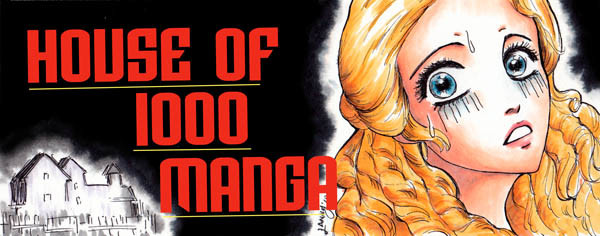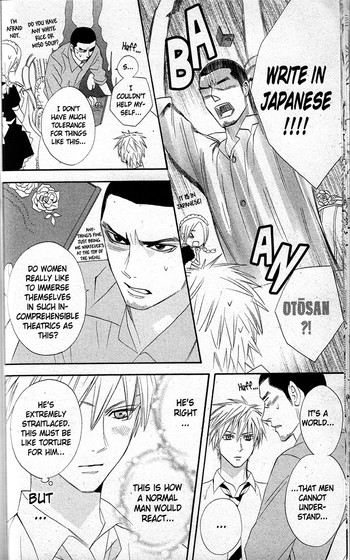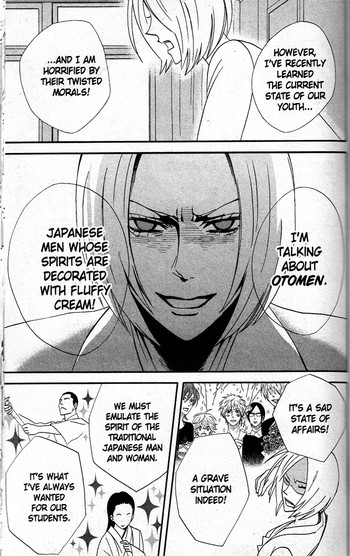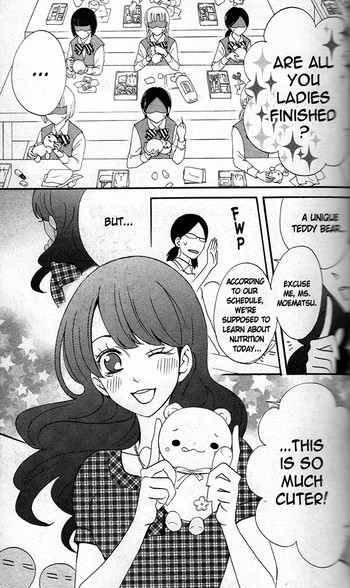House of 1000 Manga
Otomen
by Jason Thompson,

Otomen
“A business like this is so great. You can talk to other men about shojo manga like it’s the most natural thing…”\

Handsome, strong, a kendo and judo champion: Asuka Masamune seems like the ideal man. Girls swoon over him and offer him presents and chocolates, but he turns them away; he's polite to them (because that's manly), but he can't accept such girly things (that's manly too). But beneath his stoic exterior is a secret: Asuka secretly loves “girly” things, like baking cakes, cooking, and making stuffed animals. He reads shojo manga and takes long hot baths. When he beats an opponent at judo and rips the man's gi, his first impulse is to break out his sewing kit and repair the tear. Asuka Masamune is womanly: an otomen (“otome,” Japanese for maiden, plus the English word “men”).
But Asuka can never reveal his secret. His mother hates feminine men due to a traumatic incident in Asuka's youth: Asuka's dad was a transsexual who left the family to transition into a woman! Now his controlling mother, the wealthy owner of Masamune Corporation, hates the slightest sign of ‘weakness’ and dotes on her macho son (“You're the brave prince who protects the princess! You're not the slightest bit feminine!”).
Afraid of her scorn, Asuka knows he can never reveal his true self…until one day he meets Ryo Miyakozuka. A girl who was raised tough by her ultra-masculine dad (a bit like Robin in How I Met Your Mother, if anyone cares), Ryo is cute, but she's as manly as Asuka is feminine. Unlike him, she loves scary things and shonen manga. When they have to walk through the spooky school building at night, she's the one who takes his hand and leads the way. And when bullies show up to pester her, she's the one who whips out the judo and kicks their asses, aweing Asuka (who's also good at kicking bullies’ asses, but still). “I want to protect you,” she tells him with a smile, and he knows he's met the girl of his dreams.

Ryo and Asuka start to have lunch together on the roof of the school, and they're joined by a third: Juta, the charming school playboy, one of the few other people who knows Asuka's secret. It's not a love triangle: Juta seems to just want to hang out with Ryo and Asuka as a friend, as well as mooch off Asuka's gourmet homemade lunches. But Juta, too, has a secret: he's actually Jewel Sachihana, the artist of the hit shojo manga Love Chick! Asuka adores Love Chick (he's like Piro in Megatokyo: “Shojo manga has helped me with so many problems”), unaware that the hero and heroine are actually gender-flipped versions of himself and Ryo, and that Juta is secretly observing them to use them as material in his manga. Juta's biggest problem is that Ryo and Asuka are both so shy, their romance is crawling along at a snail's pace, and he has to play matchmaker or his story will get boring. (Juta's clearly a self-insertion of Otomen’s manga artist, constantly watching and commenting on the action.) Despite Juta's love for the ladies (“I like girls, that why I know how they think!”), he too is an otomen, who must hide the fact that he's a man in order to succeed as a shojo mangaka.
Like the gorgeous packed lunches that Asuka brings to school, cute on the outside and nutritious on the inside, Otomen (18 volumes, Viz) is a treat. Aya Kanno's art is so appealing, you could almost be forgiven for thinking this was just a bishonen manga about hot guys, but the story's good too. It takes a few volumes to get going, drifting aimlessly with generic manga plots like seasonal stories (a Christmas love story, a summer beach vacation so we can see the characters in swimsuits, etc.) and random crises to give the characters a chance be heroic (a wild bull going on a rampage, a fire, the traditional bullies). But endure the early volumes, because around volume 5 it gets really good and stays good ‘till the end. It's got handsome guys and beautiful girls, a plot, and so, SO much crossdressing.
Actually, there's more like two plots: the plot of Ryo and Asuka's love story, and the plot of Asuka's otomen coming out. Rather than spinning their wheels, both these plots actually develop and go somewhere (I know! Amazing!). As the story goes on Asuka and Ryo meet a variety of other gender rebels, till it seems like everyone in the series has a dark secret, or rather a fabulous, rainbow-colored one. There's Yamato, the shota-ish cute boy who idolizes “manly” Asuka and dreams of being a badass who gets all the girls (“If only I was tall and manly…someone cool with narrow eyes…”). Kitora Kurokawa is a tall, quiet boy who's obsessed with flowers; he loves tending his garden and beautifying the school, though you have to wonder if he's gone too far when he creates a cult of flower lovers who wear hoods to conceal their identity and whose motto is “Sieg Flower!” Hajime Tonomine is the #2 kendo champ in Japan, Asuka's cold-hearted rival, but secretly he's really into makeup and loves to bring out women's natural beauty with eyeshadow, lip liner and blush. In another chapter we meet Hanamasa, a visual kei rock star who howls lyrics about “the seduction of blood,” but whose dark secret is that, like Asuka, he's really into the sweet female duet Fra*Fra. (This storyline is exactly like a mini shojo version of Detroit Metal City, or at least Detroit Visual Kei City, which is probably about as metal as Bessatsu Hana to Yume can handle.)

Other authors before me have commented that the men in Boy's Love and bishonen manga don't seem exactly male or female, rather, they're more like a third sex which combines the (in the imaginations of BL readers) most appealing aspects of men and women: strength, beauty, minimal facial hair, self-lubricating penises. Asuka and the other otomen basically belong to this priviliged species (minus the lubrication; this is a 16+ book), but they're unusually well-developed for characters in a bishonen manga, a genre in which the men are often as two-dimensional as the women in a shonen harem manga. A gender-theory stickler could complain that Otomen isn't interested in putting its characters into neat little labeled boxes, but unlike many gender-bending manga that ultimately reinforce gender roles (for example Ranma 1/2, where the main character hates becoming a woman and spends the whole manga trying to become 100% man), it shows its heroes’ genderqueer urges as a good thing, oppressed by a hostile world. Every main character in Otomen is in the closet in one way or another; this is not one of those Boy's Love stories where everybody's happily gay (but never uses the word “gay”), or Mikiyo Tsuda's Princess Princess, where teenage boys openly crossdress as women and all the other guys in school think it's hot. Of course, most of the prejudice in Otomen is over-the-top to the point of silliness (“You expect me to eat food that a GUY made?!”); this is still a YA manga, and having jerks say homophobic things, for instance, would be too realistic and depressing and mood-killing.
To her credit, Aya Kanno seems totally aware of all this, aware of all the stereotypes she's playing with (like the old joke that Ryo can't cook anything), and aware of what she can and can't get away with in a mainstream manga while still keeping a basically progressive message. The scenarios in Otomen are ridiculous and fun enough to belong in a bishonen shojo manga but have enough bite to make you root for the rebellious heroes and hate the socially conservative bad guys. Villains constantly want to keep Asuka and Ryo down: Asuka's mom, Ryo's dad, and many others. In volume 8 we meet Kasuga Masamune, president of the school Morals Committee, who tries to enforce gender roles (“Girls will be neat, tidy and feminine! Boys will be simple, sturdy and manly! I want to rid the world of every last otomen!”). Kasuga's allies are four evil teachers, each one devoted to enforcing conformity in their own way. Otowa Moematsu is an evil science teacher who puts on a “girly girl” burikkoact and tries to stop the girls in her class from studying science so they can study sewing and cooking instead. Mifune Naito is a Japanese history teacher who's obsessed with samurai and traditional Japanese manliness (of course, he's from America; only a foreigner could care so much about this stuff). Suzaku Oji is a sexy biseinen teacher who flirts with all his female students. And Maki Kibino is a mad scientist who boasts “Discipline alone cannot change a person's fundamental personality! There is only one thing that can do that…SCIENCE!” In a shocking twist, Kibino brainwashes our heroes, turning Asuka into a 100% red-blooded all-Japanese male and Ryo into a yamato nadeshiko who loves flowers and cooking. Can they ever change back to their true selves?

There's many more good bits than I can spoil in this review. There's the cooking competition that turns into a shonen-manga-esque battle with knives chopping at super-speed and food flying through the air. (At the climax of the contest, Asuka is about to sneakily make Ryo's food for her so she can win, but then he changes his mind because he realizes she has to win the battle for herself.) There's the scene when Ryo and Asuka attend a party for the publisher of the shojo magazine where Love Chick! runs, and all the other shojo manga artists are drawn in the styles of other shojo manga. There's the Antique Bakery-esque subplot where Asuka takes pastry lessons from a strange, beardy chef who runs a little patisserie (“There's no other place where men can make desserts without hiding in shame!”) There's a tension-fraught coming-out-to-the-parents scene. (“Concealing the truth doesn't mean acceptance!”) And finally, there's the mystery of Asuka's long-lost father, which leads to one of the big questions: is the transsexual subplot just a gimmick to get the story jump-started, or is it actually seriously addressed…?
Suffice to say that everything is resolved in the ending. On the one hand, Otomen is a fairly familiar thing, one of the thousands of gender-bendy manga that flirts with gender and sexuality without ever committing to words like “gay”, “trans”, etc. (of course, it doesn't use slurs either). On the other hand, Aya Kanno's rebellious glee is so infectious, her mocking of gender stereotypes (and shojo manga stereotypes) so thorough, her good intentions so clear, it's something special. This is a ridiculous, funny manga about serious issues, and it totally works. When I was reading it (proudly, of course) in the local café, the barrista poured me a latte with a heart-shaped rosetta, just like the one Asuka has on his latte in volume 3.
discuss this in the forum (15 posts) |